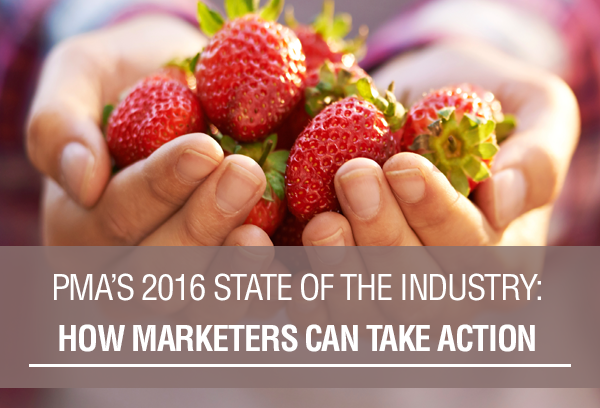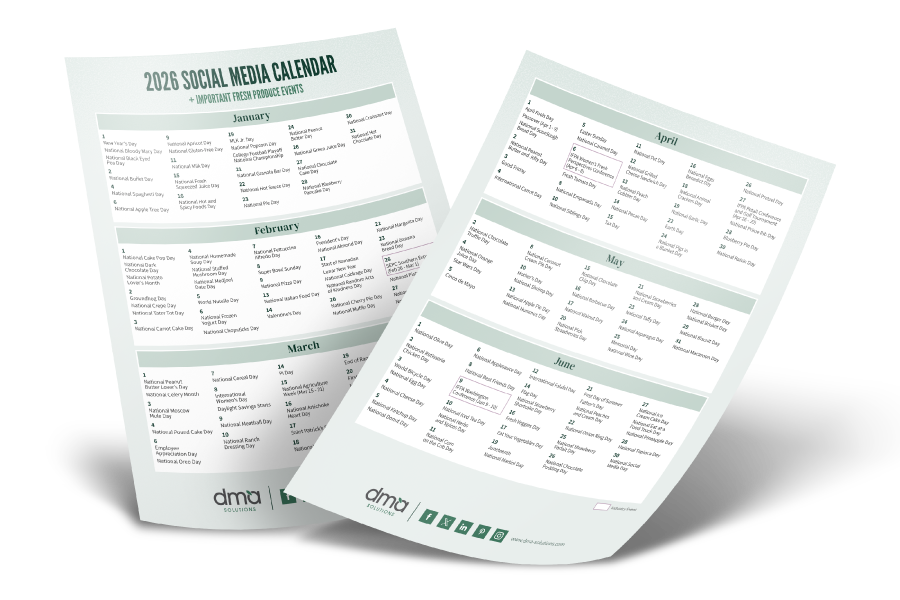 Each year I attend Fresh Summit, I become increasingly excited for the State of the Industry (SOI) presentation. This year Cathy Burns and Bryan Silbermann did not disappoint, especially considering the sentimental tone as we celebrated Bryan’s incredible career in fresh produce. For more than 10 years PMA has delivered this message and, I believe, with the intelligence that it brings to our business strategies and marketing plans, it is one of the significant benefits we receive as members.
Each year I attend Fresh Summit, I become increasingly excited for the State of the Industry (SOI) presentation. This year Cathy Burns and Bryan Silbermann did not disappoint, especially considering the sentimental tone as we celebrated Bryan’s incredible career in fresh produce. For more than 10 years PMA has delivered this message and, I believe, with the intelligence that it brings to our business strategies and marketing plans, it is one of the significant benefits we receive as members.
The 2016 presentation reaffirmed that there are infinite opportunities for fresh produce companies to sell more of their products by taking advantage of trends and changes in technology, eating habits, and generational preferences. Similar evolutions over the last five years have already caused an exciting expansion of branded produce’s dollar share from 28% in 2011 to 36% in 2016. As marketers we certainly agree with Cathy’s closing point when she exclaimed, “marketing does work!”
To close their presentation, Cathy and Bryan suggested fresh produce marketers consider 3 priorities for 2017: (1) grab and hold consumer attention, (2) design products that meet consumer demands, and (3) create an emotional connection to your brand(s). If you’re one of the many fresh produce marketers who was inspired by the presentation, but you’re struggling to turn these priorities into action, keep reading. We’re excited to present our suggestions on how you can take action and apply these learnings to affect positive change for your brands in 2017 and beyond.
Priority 1: Grab and hold consumer attention
During the State of the Industry address, we learned that the average consumer’s attention span in 2000 was 12 seconds and has decreased over 30% in 15 years to a whopping 8 seconds in 2015. That’s less than the 9 second attention span of a goldfish. For marketers, it is essential to make those 8.25 seconds count. Here are a few ways to start:
Discover the Value of Public Relations
Many fresh produce marketers that we’ve talked with have struggled over the years with the value of PR. What we often discover is that these marketers only focus on PR during the happiest of times (new products, promotions, etc.) and during the worst of times (food safety recalls, social media backlash, etc.). What we overall as an industry are missing is that the vast majority of our PR efforts should be focused on constant, dynamic storytelling about our farmers, the good our products offer, ways to use our products, food trends and more.
For example, we learned that an increasing interest in sustainability has driven consumers to pursue foods with a lower environmental impact, like fruits and vegetables. With this shift in consumer preference, Jackfruit recently received some stage time in The Washington Post as a meat alternative, because of its high protein content. Frieda’s did the smart thing and utilized PR to capitalize on this trend and increase brand exposure by sending out various press release to consumer publications about jackfruit and its value. This is simply one example of how you can start thinking about PR’s value to not only your brand, but our entire industry.
Strategically Invest in Influencer Marketing
Food bloggers, Registered Dietitians, and networks like the Produce for Better Health Foundation, are rapidly expanding their influence over consumer decisions. Many food bloggers and RDs have built strong personal brands, not only through their websites, but also through social media networks, making them a trusted resource for information and recommendations by their readers. For marketers, this means that bloggers and RDs are powerful allies who will be able to work with you to provide strategic content about your brand that their unique audience will pay attention to. Many produce marketers have already established an influencer marketing plan to some extent, but we’ve found that an understanding of how to budget for blogger partnerships is wildly inconsistent. Click here to read more in this topic and make the most out of your influencer plans next year.
Don’t Try to Capture the Attention of ALL Consumers
We know how easy it is to get caught up in the “numbers game” – meaning, we can become fixated with seeing likes, comments, and followers increase, as if that is our only indication of success. But when it comes to capturing the attention of consumers, you’re better off choosing quality over quantity. For example, we learned about that consumer niche called “sophisticated weight managers” that have a very specific set of values and desires that the brands they connect with are also invested in and communicate. Focusing on pleasing a niche audience, like these weight managers, instead of trying to be a brand for absolutely everyone is a great way to capture and keep your audience’s attention.
Partner with Like-Minded Brands
Cathy also challenged us to partner with like-minded brands inside and outside the fresh produce industry, like Fitbit or Apple, to gain additional insights into consumer behaviors. We couldn’t agree more – partnering with other companies that share or complement your values, target audiences and brand voice not only increases your exposure and reach via their brand communities, but can also increase your website traffic, social media communities and consumer contacts. Plus, there are countless CPG, culinary and kitchen brands that are ready to pair with fresh produce to broaden their own appeal to the demographics that actively seek and consume your fresh products.
Priority 2: Design Products to Meet Consumer Demands
Shaved Brussels sprouts, spiralized zucchini, cubed butternut squash… preparation style has skyrocketed in importance when it comes to consumer preference. Bowls are also growing in popularity and driving sales of vegetables in restaurants and at retail. In a world where customization is key, re-imagining the way your products can be eaten and keeping consumer preference in mind will keep your brand relevant. Beyond investing in new equipment and packaging, how can marketers contribute? You can:
Use Analytics and Measure Your Activities to Understand Consumer Preference
Gone are the days when you had to be an Excel-loving digital analyst who spends their days in spreadsheets and pivot tables to gather insight on marketing efforts (although, loving Excel doesn’t hurt). With a few smart metrics tracked over time, it can be easy to identify trends, successes and areas of improvement. Translating this newfound knowledge into personalized action items – now that’s where you can truly set your brand apart and deliver on consumer needs.
Build a Consumer Database, Ask Questions and Personalize Your Content
Building a database is an essential part of beginning to understand your audience and what they want. We believe that the more questions you ask, the more successful you will be, so start asking the consumers who have given your brand permission to communicate with them what they need and want to see from you. Once you’ve taken these steps, begin incorporating SMART technology into your efforts to personalize your website for your audience.
Priority 3: Create an Emotional Connection to Your Brand
As Cathy mentioned, we’re all in the business of creating joy. Building a brand that creates an emotional, human connection with your audience is not only rewarding, but can result in long-term brand evangelism, consumer loyalty, and a sustainable bottom line. If this is an ongoing struggle for you, ask yourself this: is it possible that your brand needs a refresh? You and your leadership may feel strong emotional ties to the brand by association, but what if consumers are not developing the same emotional ties? If so, it might be time to refresh your messaging, strategy, website, or even your entire brand identify in order to make those strong consumer connections. Here are a few other ways your brand can create meaningful connections:
Make Social Media a Priority
Building authentic relationships and emotional connections takes a huge amount of time, and there’s no way around this fact. Social media is relational, and fresh produce marketers have to start considering a deeper social media strategy built around authenticity and true connections, and just like with real life friendships, sometimes it takes time to get to know and bond with people. Today marketers have at their fingertips a direct line to their consumers like they have never had before, yet many marketers seek instant gratification with their efforts and attempt to create shortcuts instead of focusing on long-term planning to create the ROI that they need to generate. Here are a few reasons why brands struggle with creating emotional connections on social media, and how to fix it.
Understand and Communicate Your Company’s Purpose and Meaning
Cathy mentioned a recent study that found 80 percent of millennials ranked purpose and meaning in their day-to-day work as the most important thing. But only one-third of business leaders think purpose should guide decision making—for example, in how they hire and retain people, or in how they think through new opportunities. As a result, 66 percent of millennials expect to move on to a different employer by 2020.
This point is relevant not only when it comes to attracting and retaining good employees, but also when it comes to creating emotional connections to your company amongst consumers. By focusing on these values and communicating the industry and your brand’s contributions to society, you will attract and connect with your own employees AND consumers. For inspiration on this topic, we recommend Simon Sinek’s book “Start with Why” or watch this famous You Tube video.
2016 was my 20th Fresh Summit and one of the most memorable for me as marketer, industry champion, and business owner. I left Orlando with such a great sense of pride and appreciation that my career is here, with you, in fresh produce. I truly believe that all of these outcomes are achievable for produce companies because we see it happen first hand every day. We would love nothing more than to talk through these challenges and have the opportunity provide proven solutions. Consider reaching out to us for a free marketing consultation.
Let’s work together to make 2017 our best marketing year yet, because we know it can work!

